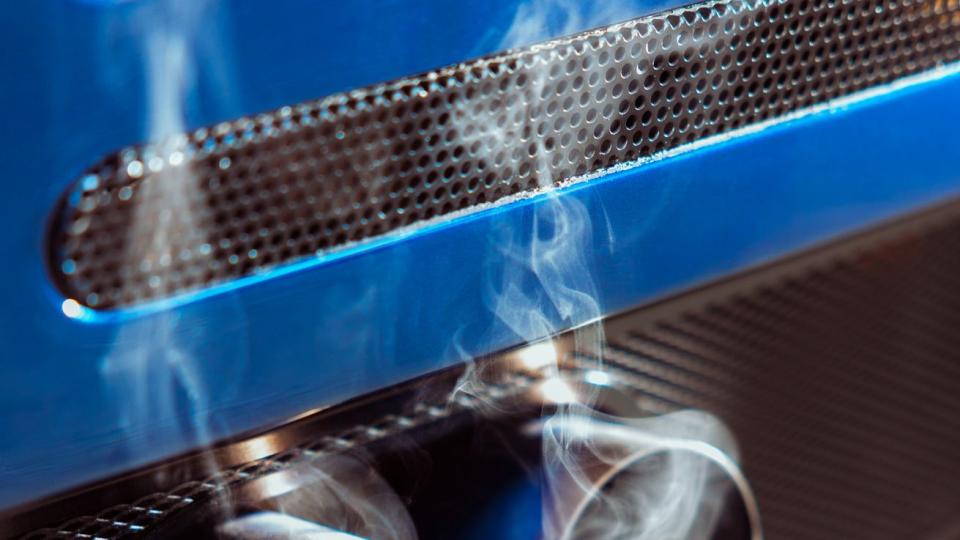The Greatest Cars We've Ever Driven

To build our list of the 20 Greatest Cars We’ve Ever Driven, Road & Track surveyed a wide range of the most knowledgeable and interesting car aficionados in the world. You can find each panelist’s full list of choices at roadandtrack.com.

Jimmie Johnson
A seven-time NASCAR Cup Series champion, Johnson has raced everything from motorcycles to stadium trucks. He co-drove the fan-favorite Garage 56 Chevy Camaro at last year’s 24 Hours of Le Mans.
Stadium Offroad Trucks: Tossing these around as a teenager was just unbelievable.
Short-track Stadium/Trophy hybrids: Beautiful tracks, esp in Wisconsin.
F1 in Bahrain: Fastest I've ever stopped, most gs in a corner,
NASCAR 2006/2007: Back in the era of 900hp and the most downforce, just insane.
Indycar: A childhood dream, marquee experience at the 500
DPI Sportscar: Lots of power, but more about the downforce and the driveability.
Garage 56 car: A NASCAR, but all polished up, more downforce - driving it in France was out of this world.
To build our list of the 20 Greatest Cars We’ve Ever Driven, Road & Track surveyed a wide range of the most knowledgeable and interesting car aficionados in the world. Find each panelist’s full list of nominations here.
Jimmie Johnson
A seven-time NASCAR Cup Series champion, Johnson has raced everything from motorcycles to stadium trucks. He co-drove the fan-favorite Garage 56 Chevy Camaro at last year’s 24 Hours of Le Mans.
Stadium Off-Road Trucks: Tossing these around as a teenager was just unbelievable.
Trophy Trucks: Shrugging off bumps and jumps that could end your life, 120 mph chewing through the terrain.
Short-Track Stadium/Trophy Hybrids: Beautiful tracks, especially in Wisconsin.
F1 in Bahrain: Fastest I’ve ever stopped, most g’s in a corner.
NASCAR, 2006–07: Back in the era of nearly 900 hp, the downforce, just insane.
IndyCar: A childhood dream, a marquee experience at the 500.
DPi Sports Car: Lots of power, but more about the downforce and the drivability.
Garage 56 Car: A NASCAR car, but all polished up, more downforce. Driving it in France was out of this world.

Jerry Seinfeld
Seinfeld is well known as a Porsche enthusiast and collector without peer. His picks on Comedians in Cars Getting Coffee indicate impeccable and eclectic taste. Also, Seinfeld once had a network TV show.
1968 VW Beetle: My friend John Flickinger lets me drive his VW Beetle 20 feet up his driveway on Sunset Boulevard in Massapequa. First time in an “import”! First time letting a clutch out.
1971 MG Midget: First time at the wheel of a true sports car! First time feeling rack-and-pinion steering, which Road & Track magazine taught me to worship since sixth grade.
Ferrari 250 GTO: My car buddy Ralph Lauren lets me drive his Ferrari 250 GTO in Montauk, Long Island. $75 million for one of these? I can see it.
1973 Fiat 128 Sport: One winter I drive it up the New York Thruway on fresh packed snow, blind in a blizzard, with nothing but front-wheel drive and 13-inch Michelin XZXs. No problem!
Porsche 908/3 (Chassis Number 008, Winner of the 1970 Targa Florio): This is pure early-philosophy Porsche-iness. Minimalism. Balance. Handling. Everything in philharmonic harmony. It disappears beneath you, and the sensation is low-level flight with the greatest steering and handling of all time.

Dario Franchitti
Scottish-born racer Franchitti sounds like Jackie Stewart but has the passion for Ferraris you’d expect given his Italian heritage. He is a four-time IndyCar champion and a three-time winner of the Indy 500.
Ferrari 250 GT SWB, Preferably a ’61 SEFAC Hot Rod: Lovely and agile and a Ferrari V-12 up front. What is not to love? My first race back after my accident was at Goodwood in a SWB, and thanks to a very kind relative, I recently used one for my daily commute to GMA for a week. It was equally brilliant at both!
Ferrari F40: In May, it’ll be 25 years since I bought mine, and every drive I’ve had in it has left my hands shaking with adrenaline. The way it delivers its power allows you to be a hooligan, but if you understand the car, you can play the boost against the available traction in a smooth way that even Jackie Stewart would appreciate!
Singer Classic: Singer takes the 911, a car that to many is nearly perfect, and makes it even better. All the tiny detail changes they make to the original car show through dynamically.
Mercedes 300SLR 722: I was handed the keys to Stirling’s baby as a 21-year-old Mercedes driver, and nearly 30 years later, I still remember just how brilliant it was.
Lancia Delta Integrale Evo 2: Typical bad Italian driving position of the time, doesn’t sound very good, non–car people think it is a box, it has just over 200 hp. But it is brilliant, one of the most fun ways to cross a bumpy, narrow Scottish moorland road.
Porsche 930: My dad had one in 1980. He sold it just before I started racing. Marino and I found it a few years back, restored it, and gave it back to him. I’ve driven it a few times since, and while I know there is an emotional attachment, I love everything about the experience of driving it.
Lancia 037 Stradale: The Lancia 037’s engine revved like a two-stroke motorbike, the gearshift was fantastic, and the chassis was beyond nimble. In a freshly restored example, we destroyed our newly graveled driveway while pretending it was a special stage. Totally worth it!
Lotus Elan 26R: A great friend and I did the Targa Florio tour around Sicily in his, and then we used exactly the same car with a slightly lower ride height to race at Donington. An incredible all-rounder, it really teaches you a lot about being smooth, managing momentum, and the virtuous circle that light weight creates.
GMA T.50: The engine is a thing of wonder. Yes, over 12000 rpm is incredible (and it sounds epic from inside and outside the car), but in fifth, it’ll pull from 1000 rpm to the redline (186 mph) too. The car is very nimble and also incredibly compliant. It’ll blast over a Scottish Highland road with such poise and lovely feedback from all the controls, plus it is small enough that you can even stay on your own side of the road! It is a modern car with performance you would expect from 997 kg and 675 hp, but it provides the driver involvement of a classic car.

Samantha Tan
A professional racing driver and team owner, Tan competes in endurance racing in the GT3 class. A longtime BMW fan, she races an M4 GT3 and drives her beloved 1-series M Coupe on the street.
BMW M4 GT3: I was the first in the world to win with this car at the 2022 12 Hours of Mugello, and it has continued to prove itself as an incredible and successful piece of machinery. I love this car because I can change essential functions, such as boost maps, traction control, and fuel selection, directly from the driver’s seat, and it’s always just such a thrill to drive. The exhaust also comes out on the side, and every time I hear it pop, it never fails to put a smile on my face. Every lap in it is a reminder of why I fell in love with racing in the first place.
Ferrari 296 GT3: I had the pleasure of racing the Ferrari 296 GT3 in the GT World Challenge Europe Endurance Cup, and it was extraordinary. It’s powered by a twin-turbo 3.0-liter V-6 engine, a significant departure from Ferrari’s traditional V-8 and V-12 engines, but this has allowed for a lower center of gravity and better weight balance. To me, the 296 GT3 is a car that combines racing and passion—it doesn’t just perform; it inspires.
BMW 1M: It was only in production for six months, and there are only 220 in Canada, where I’m from. They called this car a parts-bin special because it has an M3 chassis, a Z4 35is engine, and essentially a 135i wide-body, but in my opinion, that just adds to its charm. This is my personal car that I’ve had for many years. It’s just an absolute pleasure to drive. It’s nimble and well balanced, with a six-speed manual, making it the perfect car for any enthusiast, especially me!
Ferrari 458 Speciale: I think this is one of the best modern Ferraris ever made. It’s got everything you want: 597 hp, a beautiful design specifically tailored to be lighter in weight with lots of carbon-fiber and aluminum pieces, amazing balance, and a 9000-rpm redline. The Speciale’s only downside is its sound system, but who needs that when you can just listen to that spectacular naturally aspirated V-8 sound?
BMW G80 M3 Competition xDrive: Regardless of your opinion on its aesthetics, you cannot deny its incredible performance. The G80 M3 Competition is equipped with a twin-turbocharged inline-six producing up to 503 hp and 479 lb-ft of torque, which makes it the perfect track toy, and, with the xDrive feature, also a versatile car you can drive in any condition. Additionally, if you’re a parent, you can still fit the kids in the back.

Valentino Balboni
As Lamborghini’s chief test driver, Balboni spent more than four decades honing Sant’Agata’s finest vehicles to razor sharpness and retired only because the Italian government told him he had to.
Lamborghini Miura: Filled with character and personality. The engine sound combines with the air intakes just behind your ears, giving never-ending goose bumps.
Lamborghini Countach LP400: It’s an extremely demanding car to drive but also extremely rewarding. The initial discomfort becomes a pleasure, part of the driving experience.
Ferrari California Spider: It provides the feeling of having your dreams transformed into reality.
Ferrari 288 GTO: Stirs a constant desire to drive it.
Fifties Corvette Convertible: A strong emotional connection. Power and torque are not the priority here.
Pagani Zonda: It’s an amazing combination of components that are perfectly integrated. It can’t help but make you smile.
Lamborghini Aventador: Distinguished by its incomparable exclusivity. Getting behind the wheel of an Aventador can make anyone a driving enthusiast.
Bugatti EB110: Remarkably easy to drive and prompt steering reaction thanks to a balanced suspension geometry.
Ferrari F40: A balanced compromise: a thrilling road car that easily transforms into a racing mode at the track.
Any Koenigsegg: It’s a missile on four wheels directed with the steering wheel. Be prompt and ready—you will always arrive home early.

Jeff Zwart
Longtime Pikes Peak International Hill Climb competitor Zwart is an accomplished racer and film director who got his start as a photographer at Road & Track. He’s long been a fan of all things Porsche.
Porsche 908LH: First the sound, the clicking and clacking that plays over the rich sound of the flat-eight. The second is just what it must look like to see it from the outside. The stretched prototype shape of the long tail is just an amazing visual.
Ford GT (New): I shot the Super Bowl commercial for the new Ford GT, and it was amazing to settle into a car that had such a retro feel but drove in such a modern way.
McLaren F1: Just to sit in the middle of a supercar and know the significance of this car, not just when it came out but what it is today. It is so refined and so racy at the same time.
Porsche Carrera GT: The sound of the V-10 is totally addictive. You just want to pull each gear to redline and let the sound speak for the experience.
BMW M1: To think that the M1 came out in 1980, yet every time I drove it, it felt fresh and modern. It is a car that is so passive in steady driving, but the moment you accelerate, the whole cabin lights up with a sound that defines it as something different.
Ferrari F50: The car felt so big walking up to it, but once you started it up and pushed it, the faster you drove, the smaller it felt. Being in an open car and having the 12-cylinder behind you was an amazingly visceral experience.
Audi RS6: This was a sleeper. With its twin-turbo V-8, it pulled like crazy while accelerating, and in the snow, the traction was tenacious. It was a simple four-door sedan from the outside, but a rocket-feeling car and so solid at speed.
Porsche 914/6: Such a simple car. The 911 engine was right behind your head, and the feeling of being centered in the car gave you the feeling you could do anything in it.

Mario Andretti
Andretti is the greatest Italian import since pizza—an F1 champion and a winner of the Indy 500, not to mention countless other races in everything from sprint cars to stock cars to endurance sports cars.
1957 Chevrolet Bel Air: My very first new car that my dad bought for my twin brother, Aldo, and I to share. It had a 283 engine, and we installed Corvette fuel injection. Dual exhaust, pair of blast packs.
1972 Ferrari Daytona: The first Daytona for the American market with the alloy wheels; it had spoked wheels after that point. That car was just amazing. I remember my wife, who was not into cars, loved-loved-loved that car like no other car I’d driven. The rumble of the engine. I’ve had Ferraris later. But that was the car.
1969 Brawner Hawk: In racing, what do you remember? You remember the cars you won in. [This is the car in which Mario won the 1969 Indy 500 and the championship that year.]
Lotus 78: The livery, the shape of the car. The car that won the Formula 1 world championship. I was so fortunate to be part of that.
Lola T332, Formula 5000: I think I could have won every race I competed in, in this car. It didn’t have the reliability, but it led every race I drove it in. Nobody ever beat me when I was driving in that car, if it lasted. It was faster than a Formula 1 car.
1972 Ferrari 312: Jacky Ickx and I drove this sports prototype and won enough races to win the manufacturers’ championship. It was a very sincere car. What I loved about it was that it was so nimble, it almost felt like a single-seater. I remember a nine-hour race in South Africa—I dropped out with a fuel pump that just let go when I was leading. We got the car back, and we were 23 laps behind. We kept running and finished second after nine hours.
Viceroy Watson-Chassis Dirt Car, 1973–74: In 1973, USAC had a separate championship for dirt cars. Al Unser and I were driving for Parnelli. We had the two cars with double-overhead-cam engines. Between Al and I, we won almost every race for two years. In the first year, he won the championship, and I came in second. And in the second year, I won, and he came in second. Great memories of my last ride in dirt racing.
2018 Lamborghini Aventador: If I am ever feeling down, I go down there, in my garage, and start this car. I love the first rumble of the engine: Vroom! I have a CD of Pavarotti, and I put that on. Jesus! You know what? I smile the rest of the day.
2023 Chevrolet Corvette Z06: The latest car I have is the Z06. With the flat-crank engine, 8600 rpm. That package is really interesting—just awesome. I love that car! The handling, the dual-clutch gearbox. The sound of the engine. It’s the most powerful normally aspirated engine that GM has ever produced.
Mini Clubman John Cooper Works: One car that nobody would ever expect or pay attention to is this Mini Clubman John Cooper Works car with everything on it. Goes like hell. Sounds beautiful. Handles. I’m having the most fun with this car. Who would think I would fall in love with a Mini?

Lyn St. James
A former Indy 500 rookie of the year, St. James is quite literally in the Automotive Hall of Fame. Among the successes in her long career are class wins at the 24 Hours of Daytona and the 12 Hours of Sebring.
1967 Pontiac GTO: Some buddies of mine owned it, and I drag-raced it at a local drag strip. You go down, and either you get eliminated or you move on. He lost, and I teased him. He said, “If you’re so good, why don’t you drive it?” I ended up winning in that class, and I came home with this big trophy. My very first race. And that car will always be near and dear to my heart.
1967 Pontiac Catalina 2+2: We drove from Cleveland to the Detroit auto show at Cobo Hall. I saw this Catalina, plum colored, and thought, This is the car I want. They were trying to talk me out of it, saying this is not an appropriate car for a young lady. But I ordered that car and drove it for three years.
1978 Chevrolet Cosworth Vega: I drove this car, but I also raced it. Traditional black with the gold Cosworth. I raced that car in SCCA in Showroom Stock A. I made it to the runoffs and blew the engine. And that was the end of that car.
1990 Mazda Miata: My Miata is almost the love of my life. I have owned it for decades now. It was my daily driver on occasions, but now it sits in my garage. It has 40,000 miles on it. The shifter, the steering—everything in this car is right.
1983 Porsche 930: I recently drove two Porsches, a 1983 Porsche 930 street car and a 2017 Porsche 911 Targa, and gave hot laps at Road America. Oh my God! These are fabulous. They really made so much improvement in weight balance. Both of those cars, for different reasons, changed my view of Porsches. The 2017 had a little bit too much whiz-bang technology. But on the 1983 Porsche, everything was understandable and worked good.
1994 Lola T94/00 Ford-Cosworth XB Indy Car: It was the first time I had a new chassis. The ultimate power, a new chassis that was right. The sweetest combination of handling, power, speed, handling—everything. And I qualified outside on the second row at the Indy 500.
1984 IMSA Argo Cosworth Prototype: It was the first car I drove with ground effects and the first time I had driven a prototype. I campaigned that car for 10 races in IMSA. The car was built around me. I had never had that. We finished fourth overall at Watkins Glen. It was just wonderful.
1989 Spice 3.5-Liter Cosworth: This is the car I raced at Le Mans with Gordon Spice and Ray Bellum. Gordon Spice was the owner and developer of this Spice chassis. The car was set up so well, and we ran so well for 16 hours. I got a lot of great laps in, and it was just awesome. My first time at Le Mans.
1976 Chevron B39, Formula Atlantic: Back in the Seventies, I would see these Formula Atlantic cars that would race. Rahal and James King. I always thought, “I would sure like to race a Formula Atlantic car someday.” Well, I finally got to, in my vintage world. I campaigned it for three years and won a race at Thunderhill. The last time I won a race! I have pictures of it all over my walls.
2007 Kevin Doran Ford GT GT3 Spec: Kevin Doran, I met him way back. He has his own race shop. He builds off the 2007 Ford GT design. He built a Ford GT, GT3 Spec. It’s got a big honking motor in it, adjustable power steering, a seat that has all these custom capabilities so I could reach the pedals. It has perfect balance, handles like a dream. I ran it at Watkins Glen, Daytona, and Indy, in vintage racing. I told Kevin, “This is my race car. It feels like you built it for me.”

Bruce Meyer
Meyer has served as founding chairman of the Petersen Automotive Museum in L.A., topped 200 mph at Bonneville, and amassed a collection of some of the finest cars, including Le Mans winners.
Shelby Cobra CSX 2001: The first production Cobra ever made.
1932 Ford Highboy, Bonneville 200-mph Club Car: When I was growing up, the ’32 Ford roadster was the essential hot rod. Bonneville, for hot-rodders, it’s either the Bonneville Salt Flats or the dry lakes. For me, going over 200 mph in that ’32 hot rod was a dream. That’s my most thrilling ride ever.
1967 Ferrari 275 GTB/4: My Ferrari history started in 1967, when I was having my Porsche serviced at Estes-Zipper dealership, and that’s when I first saw a Ferrari that knocked me out. That was the 275 GTB four-cam. I was able to buy that car, and I have owned it now for 53 years.
1973 Porsche 911 RSR: I recently bought a works-entry, factory-built RSR hot rod that raced at Le Mans in 1973. It’s gorgeous. Martini livery. I had it at Rennsport. That’s a super-important car.
1979 Porsche 935, Le Mans Overall Winner: This car was on the cover of Road & Track magazine!
1987 Ruf CTR “Yellow Bird”: The first Ruf biturbo coupe. Only 29 made. This thing is wicked fast. It astonished the world when it came out.
Pierson Brothers Coupe: A 1934 Ford hot-rod coupe I drove at Goodwood.
2009 Corvette C6.R, Le Mans Winner (Class): If you go on YouTube and put in “Bruce Meyer and Le Mans Corvette,” you’ll see. That one is pretty cool.
1965 Bizzarrini A3/C, Le Mans Winner (Class): That thing is insane.
1929 Bentley 4½: It’s important, because in the realm of Le Mans, the 4½-liter Bentley was the winner. My 1929 Duesenberg photographs better than the Bentley, but the Bentley is more sporting.

Dave Coleman
A vehicle dynamics engineer at Mazda, Coleman is one of the reasons a mainstream crossover like the CX-50 drives so well. A former magazine editor, he also has a love for building wild project vehicles.
1997 Subaru WRX STI RA (Specifically, the One Lap Car in Subaru’s Museum): This car is the physical manifestation of the ethos of underpromise, overdeliver. It looks like a penalty-box rental car, but it’s explosively powerful (280 hp, with gearing so short that it tops fifth at 130 mph), lightweight (2600 pounds!), and nimble (rear-biased planetary center diff and 13:1 steering ratio), and it gets better as the roads get worse.
The Evo VI Built by Bozz Speed in Japan: They stripped out so much weight, you could see the firewall through the dash vents, and they tuned all the most difficult parts of the car (like repeatedly restacking the center differential’s clutches and subtly differentiating front and rear tire behaviors by using wider front and narrower rear wheels on the same-size tires). Unlike the STI, this was a dedicated track car, but it drove so intuitively that it instantly made me feel like a hero in a new car on an unfamiliar track.
1998 Acura Integra Type R: I don't think we really appreciated how special this car was at the time. Honda did things to this car that only they could do, changing sheetmetal thicknesses, tweaking production processes, tuning the seats to be part of the suspension. Doing this in pursuit of a pure, lightweight driver’s car instead of a Nürburgring lap time is what really made this distinct from the modern Type Rs. I miss that purity of purpose.
Base-Model Lotus Elise: The U.S. one, with the 2ZZ engine, but with the little 175 pizza cutters on the front, an LSD, and no supercharger. The suspension on the base models is supple in a way the track package is not, and the small front tires demand a mid-engine trail-braking driving style. Once you figure it out, there’s a delicacy and a balance you don’t feel on the cars with supersticky track tires.
2024 MX5 RF Club: This car is a strong argument for long model cycles. Fine-tuning an existing platform lets you dial things in to a level that’s impossible on a new car. Just ask Porsche. I prefer the RF’s steering, as the slight rigidity boost of the closed top makes the response more linear. If I had my way, I’d take a Club without the BBS/Brembo package, just because my hindquarters sink into the standard seats better than the Recaros. But that spec doesn’t currently exist, since the customer base is exclusively steering nerds over six feet two.
My Own Hayabusa-Powered NA Miata: 2016 pounds, 11,000 rpm, illegal, dangerous, stupid. I get the adrenaline shakes just thinking about it.

Ralph Gilles
Gilles is an accomplished designer with a love for old-school muscle and classic Italian elegance. As the chief design officer at Stellantis, he’s making sure we haven’t seen the last of big, bad Dodges.
Ferrari 458: What I love about the 458 is its super-quick steering, its very tossable rear end, and the perfect linearity of the naturally aspirated V-8, not to mention the wail of that engine in Race mode near red.
Maserati MC20: Such an incredible GT with a supple ride and shockingly good fuel economy. Then you put it in Corsa mode; it’s shocking how much you can feel the benefit of its ultra-stiff carbon monocoque. The suspension is left to do its job, absorbing curbs and road irregularities as if they aren’t there. The front-end grip is tenacious, and the back end is obedient.
Porsche Cayman GT4 RS: If you’re looking for a budget supercar experience all around, this is it. It’s perhaps only slicks and an alignment job away from being an all-out track car. I really enjoy its forgiving nature, as it can be driven intensely and not take you out. Clearly, the Cup car’s DNA is ever-present. The brakes are infallible.
Peugeot 205 GTI: I must say, 35 years later, and it may still be the gold standard of front-wheel-drive goodness. The front end is on rails, and the back loves some lift-throttle oversteer.
Radical SR3: Such a joy to drive. A deceptively quick race car that makes 190 hp feel like 500 hp. Thanks to its prodigious aero package, you feel like you can’t ever seem to find its limits. It literally makes you a better driver as you discover the chassis’s true and endlessly tunable depths.
2016 Dodge Viper ACR: It is 55 millimeters shorter than a 911 but feels twice as big initially as you peer over its long, bulging hood. However, once you dance with it on track, it feels like a Miata that just happens to have 645 hp and a shocking amount of grip. In modern ACR guise, there’s 1850 pounds of downforce, most of which is available below 120 mph. Makes it a giant killer on any road course in the world.
Ford GT: For a car that looks like a show car, it’s so easy to drive at the limit. It’s a very benign, no-bad-habits car with incredible corner-exit grip. It has brakes for days and plenty of power. The only downside is its challenging visibility.
McLaren Senna: Sadly, most of these vehicles will live only on display in collections. I was able to drive one for several laps at Lime Rock Park, and it’s an “OMG car” that seems to have come from Stark Enterprises.
1966–75 Alfa Romeo GT, GTA, GTV: Such a lovely little chassis. Its extra-tidy size means it has great power to weight. With a little tuning, it becomes a grin-inducing and wondrous little icon. A fun live-axle back end that just loves to drift yet somehow keeps clawing its way forward.
Mazda Miata (or, Should I Say, Lotus Elan): To me, they are spiritually the same ethos. I love this car and the effortless way it deals with physics. It is the professor of the apex. Master it and you are ready for about anything else.

Spike Feresten
Screenwriter Feresten hosts the podcast Spike’s Car Radio, and his car collection includes a Zagato-bodied Porsche 356. He found Steve McQueen’s Porsche 917 in a showroom in Hollywood.
1970 Porsche 911S: For me, the perfect early 911. I’ve driven them all, but I always come back to this one. Light, quick. The 911 that finally casts off its 356 vibes.
1979 Honda Accord LX: In 1981, just after I got my driver’s license, my dad came home with a used Accord. We’d only driven heavy American cars, the Honda looked like a F1 to us. Bucket seats. Manual gearbox. It was my mom’s car, but I took it every chance I could get.
Ferrari Dino: In the early Nineties, David Letterman let me drive his 246 GTS in Santa Monica. He said, “This car will make you laugh.” I turned onto Ocean Park Boulevard and gave it a rip. I remember thinking that the car made me feel like Speed Racer. The exhaust note. The little black ball on the shifter.
Porsche Carrera GT: For me, every drive in a Carrera GT is memorable. The full-focus difficulty of the driving experience. The yowl of that engine is like no other. It’s still hard to believe this was sold to customers for street use.
Porsche 911 GT3 4.0: There are many Porsche GT variants that have a perfect balance of elements, but for me, the 4.0 stands out as the best of the best. Sound, steering, shifting, and braking all calibrated perfectly and working as a team.
’98 Porsche 993 C2S: My first new 911 was a PTS Dunkelblau 993 C2S. I had many adventures in this car. I miss this car. It was stolen a second time and disappeared for good. The smell of any 993 interior takes me back to all the great drives.
Porsche Cayman GT4 RS: It’s perfect. I could put a million miles on mine. It’s the one that calls to you from the garage. Let’s go to work. Let’s hit the canyons. It does it all.

Brian Scotto
For Scotto, producer of Ken Block’s game-changing Gymkhana films and co-founder of Hoonigan, it’s all about slaying tires. It’s not about transparent horsepower but the joy of wringing a car’s neck.
Mk 1 VW Rabbit GTI: I owned one when I was 20, and I do again now in my forties. This is the definition of “It’s better to drive a slow car fast than a fast car slow.”
Mitsubishi Evo IX: When it was new, I was still the editor-in-chief at 0-60, and we’d make up reasons to always have one from the press pool. Has the fit and finish of a ham sandwich but was the most intuitive production car to drive on the edge.
Porsche 964/965: My first 911, purchased before the boom of air-cooled Porkers. Still have yet to drive another car that excites the senses in the same way.
Volkswagen A59 Rallye Homologation Prototype: In 2022, I got the chance to drive it at partial anger on track. My first car was Mk 3 Golf. The A59 is what my teenage brain believed my grocery-getter hatchback was.
Audi B7 RS4: I own an RS2 but will be the first to admit that the B7 RS4 is the better driver’s car. When it was released, I held the record for most miles put down in the global press fleet—over 6800 in 14 days.
Lotus Exige: What it lacked in noise, it made up for in rawness. What a fun car, on both track and back roads.
2005 Ford GT: The first terrifyingly fast car I ever drove, and subsequently the first big whoops moment I had on track (spun Turn 11 at Laguna).
Mazda RX-8: It’s downright ugly. You have to wring its neck for any acceleration, but boy does it handle.
Ferrari 360 CS: I own a Modena that has been NGT kitted, so very similar to the CS. It’s the first daily-driver Ferrari, but it still feels raw enough to not feel like a daily driver. The noise is everything.
Corvette C6 Z06: On track, it was just good. And as a Porsche snob, I didn’t want to prefer it to the 997 Turbo I was comparing it to.
Audi 4000S: I have a shit-box 4000S that has dry-rotted snow tires and a blown-out suspension, but I just love how it drives on old, beat-up country roads.

Bruce Canepa
A racer and collector-car specialist, Canepa is known as the 959 whisperer. His company cares for many customer 959s and can turn Porsche’s Eighties supercar into a rival for any modern metal.
Mercedes-Benz 300SL, Gullwing or Roadster: Ahead of its time for a Fifties car and plenty of performance. Mercedes has never built anything prettier.
Porsche 356: Light, agile, quick, comfortable, does it all, timeless style.
1961 Ferrari 250 GT SWB: Not usually a Ferrari guy, but this one checks every box.
1965 Shelby GT350: First great American muscle car. You have to drive it, but it does everything well.
Shelby Cobra: Love the 427 I have (last one made). The best American sports car.
1973 Porsche 911 Carrera RS: Supremely well-balanced car, light, right-size tires, better than anything on the road in 1973.
Porsche 959: An obvious choice for me, but my absolute favorite. People drive them—I’ve had a 165,000-mile 959 in the shop.
993 Porsche Turbo: I like all the 993s, but I like power, and you might as well have all-wheel drive with the turbo.
Porsche 918: One of the first sophisticated modern supercars, ahead of the curve.
2020 Ford GT: It’s an exotic, but the blue oval means you still get the thumbs up.
Gordon Murray T.50: Back to basics, 2200 pounds, 12,700-rpm redline, and more practical than the McLaren F1.

Hiroshi Tamura
Tamura earned the nickname “Mr. GT-R” for both his longtime passion for the R32 Skyline and his work at Nismo, Nissan’s motorsport division. He fought to get the current Nissan Z approved for production.
Lamborghini Countach LP500S Wolf Special: Nice styling, V-12. The final Countach with six side-draft twin-choke carbs.
Mercedes-Benz (W124) E60 AMG Limited: A 6.0-liter version of the AMG E500. It’s true that four-door sedans are not “sports car” shaped. But if we can say that “sports car” is also a phenomenon of feeling, I felt that stimulation from the E60 AMG, with its high-speed stability, acceleration, and V-8 note.
Nissan Fairlady 280Z-T (S130) Kai 3.1-Liter Turbo ABR Special: A legendary early tuner car from the days of top-speed attempts in Japan.
1989 Nissan Skyline GT-R (R32): My longtime personal car. Bought new, tuned to 600 hp. It feels like my “buddy.”
Porsche 911 GT2 RS MR: Broke the record for fastest street car on the Nürburgring. I’ve met Mr. Manthey, and I like their philosophy.

Bob Lutz
Lutz is a former Marine pilot who served as an executive at BMW, Chrysler, Ford, and General Motors. Under his watch, automakers developed icons such as the BMW 3-series and the Dodge Viper.
2005 Subaru WRX: Instant throttle response, an excellent five-speed manual, superb brakes, intrusive (but thrilling) engine soundtrack and flawless man-machine interface. No wonder it was the vehicle of choice for young enthusiasts in Switzerland’s mountainous regions. This low-slung sedan with all-wheel drive provided what the enthusiast craves on twisty roads. It could embarrass the “noble brands” from all countries.
Aston Martin DB4 GT Zagato: An acquaintance lent it to me for one stage in a California Mille. With its excellent power from a smooth but powerful inline-six, coupled with low mass and a superbly set-up chassis, this car was an unforgettable thrill to drive in an essentially unpatrolled mountain stage. It felt light, super-agile, and tossable, with precise steering and brakes.
Ferrari 250 Testa Rossa Competition Roadster: Another California Mille loaner for another fast mountain stage. Incredibly light and tossable, with easily provoked but easily controlled power oversteer. It became easy to understand why the car, those many years ago, was already worth over $5 million. The gearbox and the fabulous V-12 alone were worth it, and the design remains one of the best ever.
1966 BMW 1800 TISA: This was the precursor to the 5-series. TI meant fuel injection, and SA stood for Sonderausführung, or special edition. Opel had one in the competitive fleet for benchmarking purposes, and I grabbed it as often as I could. It was extremely fast for its day, light, and well balanced thanks to the small four-cylinder engine. The chassis was firm, with superb feedback, and the drivetrain was highly audible but inspiring. On winding roads, it seemed to beg the driver to push harder and harder. For a fairly large four-door sedan, it was incredible.
1972 BMW 2002 tii: Other than the rare limited-edition 2002 Turbo, this was the top of the 2002 line. Again: light, fast, supremely responsive. Quite possibly one of the all-around-best BMWs ever offered. It demanded attention, as terminal oversteer could occur faster than the driver expected (ask me how l know this!).

Chris Harris
Journalist and TV presenter Harris has spent a life drifting incredible machinery across U.K. roads and racetracks. He can often be found at the wheel of some priceless machine at the Goodwood Revival races.
Ford Focus 1.6 Ghia: It was so much better than anything it should have competed with that I felt sorry for the opposition.
Citroën 2CV: The definition of greatness. It was built for the masses with an ingenuity and charm no car has matched since. Later 602-cc cars I like less.
BMW M5 CS: The most complete driving device I’ve ever experienced.
1974 Porsche RS 3.0: The “performance” car that most made me think deeply about stealing it from its owner. If I owned that car, I wouldn’t desire anything else.
Land Rover Discovery 4: Another marker of greatness that people overlook is the inability for newer versions of cars to adequately fill the shoes of their predecessors.

Bill Warner
Racer and photographer Warner has owned everything from a Lotus Eleven to a V-8-powered IMSA Triumph TR8. He founded the Amelia Island Concours d’Elegance near his native Jacksonville, Florida.
1971 Porsche 911T: Have had one for 52 years. Light, nimble, and quick, with room for wife and luggage.
1959 Ferrari 250 GT SWB: Balanced, fast, and beautiful. Nearly every Ferrari aficionado’s favorite. It is much more civil than a GTO and more usable, and that scream of the 3.0-liter V-12 at 6000 rpm is a symphony unmatched by the New York Philharmonic.
1971 Ferrari 365 GTB “Daytona”: A man’s car. Brutal, heavy, fast, and beautiful. It is the last of the great front-engine Ferraris.
2020 Chevrolet Corvette (C8): A bargain, quick, comfortable, practical (plenty of luggage for trips), economical (variable displacement, V-8/V-4). Certainly one of the best-engineered new cars on the market—at any price.
Mercedes S550 Sedan: A real panzer wagon. Eats up miles like a fat man eating Krispy Kreme doughnuts. As comfortable as a living-room sofa, and as big as it is, it feels nimble. The perfect car for a long road trip.
1965 Brabham BT8 2.0-Liter Sports Racer: I owned one for 12 years and raced it. The car had no bad habits and was really quick with a Coventry Climax motor. Mine was driven to victory at the 1966 Tourist Trophy by Denny Hulme, beating many larger-displacement cars. One of the best-handling sports racers of the Sixties.
1959 Ferrari Series 1 Cabriolet: Arguably the most beautiful Ferrari ever, the Catherine Deneuve of automobiles. Simply beautiful and the car of royalty. I like it for the transparent beauty. Guaranteed front-row parking at the Beverly Hills Hotel or Joe’s Stone Crab in Miami Beach. It is stunningly elegant.
1939 Alfa Romeo 8C 2900 by Touring: This simply the most beautiful sports car ever. Elegance on wheels. I dare anyone to find a bad line on it. The only thing I don’t like about driving one is the pedal arrangement: clutch on left, gas in center, brake on right. Makes my teeth hurt figuring out where to put my feet.
Group 44 Triumph TR6, Two-Time SCCA National Champion: I would argue it to be the best production race car of the Seventies. It will go where pointed and stop with the best. Acid dipped, tricked out with Mercedes half-shafts, Girling brakes. I beat a lot of larger-displacement cars with it. After 28 years of racing it, getting into it was like putting on an old comfortable pair of shoes.

Sera Trimble
A professional stunt driver, Trimble has been sliding cars across screens for over a decade. Stunt work is a behind-the-scenes profession, which pairs well with her under-the-radar daily driver, a Ford Fiesta ST.
997 Porsche GT3 RS: All things perfection in a car. Transmission. Steering. Overall sensation of sound. This is all I’ll ever need.
Ford Fiesta ST: It’s the daily. My friends love to jest and ask why, when I have a handful of other things, why that? But if you know, you know. It’s just my favorite to drive around town. Small for parking, agile, and quick.
2005–06 Ford GT: This is a car I will love unconditionally.
2011 BMW 1M: Lovable in every the ways the Fiesta ST Is lovable—just add that German steering and power feel. Danke.
Nineties Jaguar XJS v-12 Convertible: Drove one on a Dior commercial, doing doughnuts all day stunt-doubling Natalie Portman. It was pink, and the tire smoke was pink.

Peter Egan
Road & Track alumnus Egan is well loved for his evocative writing and his Side Glances columns. He is an accomplished club racer, an avid motorcyclist, and a raconteur whose stories have become legend.
Jaguar D-Type: In terms of transparent beauty and racing success, the Jaguar D-type is, hands down, my favorite car of all time. I finally got to drive one while doing an R&T story in 1986.
1987 Ruf CTR “Yellow Bird”: It was the clear winner of the “World’s Fastest Cars” cover story we did for July 1987.
McLaren M8F Can-Am Car: The M8F was the final development of the Chevy-powered McLaren design that propelled Hulme to two Can-Am championships and twice as many wins as any other driver in the eight-year history of the series.
1951 Ferrari 340 America Vignale Spider: Not much fun in slow city traffic, but everything got easier and smoother with speed. It wanted to go fast and be driven hard all the time.
Lotus Super Seven: This was the bare-bones but handsome car that reminded many of us what a “sports” car was originally intended to do: go fast and win races against other cars of equal (or greater) displacement. That, or just provide good times on winding back roads.
Porsche Boxster S: I am still stopped in my tracks by the sight of any clean Boxster or Boxster S in a parking lot and have to walk around and admire it for a while. Besides being a great all-around sports car, it reignites some subliminal flame left smoldering since the days of James Dean and the 550 Spyder.
Austin-Healey Bugeye Sprite: By the time I started racing a Bugeye in 1973, it was not unusual to have a starting field with 20 Sprites and five or six slower off-brand cars on the grid.
Mazda MX-5 Miata: Bought a 1991 BRG Special Edition NA (first generation) Miata from a friend who’d installed shock tower braces and Koni shocks, and I may never sell it because the thing now handles like a Formula Ford with a convertible top.
Swift DB1 Formula Ford: Like the Porsche 917 in Can-Am, the DB1 was a game changer.
1964-½–66 Ford Mustang: The Mustang’s arrival was a watershed moment in the Sixties, and I turned 16 just as this original “pony car” hit the showrooms.

Loris Bicocchi
Perhaps the ultimate supercar development driver, Bicocchi has had his hands on the wheel of everything from the Bugatti EB110 and the Pagani Zonda to the Koenigsegg CCX. And he still likes Mazda Miatas.
Bugatti EB110 Super Sport: I strongly believe that the performance of the Bugatti EB110 SS can still be very astonishing among more modern supercars. I would give a 10 to the whole package.
Mazda MX-5 (ND): I could drive many miles in this little sporty car, and I have also chosen it for my driving academy in Italy.
Porsche GT3 RS 997 3.8: I drove this Porsche on a racetrack, and I did not want to stop. The car itself seemingly did not want me to stop.
Lancia Delta HF Integrale 16V: The Lancia Delta Integrale is one of the best emotional machines I could enjoy driving.
Lamborghini Huracán STO: The STO is the ultimate machine: fun, precise, and track oriented.
Bugatti Chiron: Pure fascination: a very progressive and endless push from the 1500 hp and 1600 Nm of torque.
Dallara Stradale: I believe there is no other road-legal car that gives such a pure driving feeling.

Daniel Pund
Pund is the editor-in-chief of Road & Track.
Porsche Carrera GT: It’s the last analog hypercar. And it sounds better than a Ferrari V-12.
Ford Fiesta ST: I cannot think of a vehicle that offered more fun per dollar than the Fiesta ST. An absolute joy machine.
Porsche 911R: Yes, the 991-generation 911R is a sop to nostalgia. It even has pepita-upholstered seats. And yes, the GT3 Touring, which arrived shortly after, was nearly as good. But I don’t care. The R hit the perfect balance of 911-ness for me. It helps that when I drove the 911R, I was chasing Porsche factory race car drivers through the countryside outside Stuttgart.
Lexus LS400: Forget the German luxury competition of the time; this V-8-powered sedan was quieter and smoother than a modern electric luxury car. The LS is a vehicle buffed clean of even the slightest imperfection.
Mazda Miata NA: When I think back to those first Miatas, I can’t help but envision them as blaring primary-color aliens dropped improbably into a gray world. Such was the impact on my teenage brain.
Grave Digger: Is there a more kick-ass way to hyperextend your neck than to land a big-air jump in the king of all monster trucks? No, sir, there is not.
Ford F-150 Raptor: Grave Digger is a cartoon; the Raptor is its real-world analogue.

Eddie Alterman
Alterman is the chief brand officer of Hearst Autos and a contributing editor at Road & Track.
Porsche 997.1 GT3 RS: The 997 GT3 feels like the last of the real, visceral, small 911s. And this is the best one—the high-revving 997.1’s 3.6-liter gets my vote over the 997.2’s 3.8 or 4.0. I know I’m in the minority.
Mercedes-Benz 300SL “Gullwing”: Reverse-engineered from a racing car and yet an absolute and serene joy on the road. Could daily, given the funds. A magnificent Jekyll-and-Hyde kind of car, not unlike...
Acura NSX: When this thing came out, the car magazines called it the “No Sex,” but they were wrong. So, so wrong. They talked about its reliability as if it were a bad thing. This is the gentleman’s supercar, as precise as it is thrilling. A masterpiece of Japanese carmaking, and Gordon Murray’s bogey for the McLaren F1.
McLaren 720S: Staggeringly quick. Futuristically gorgeous. And gloriously vintage in certain important aspects, namely the steering feel. Take it up the back straight at COTA, jam on the brakes, and watch the airbrake behind you undo all that speed. There are few better experiences on this earth.
Nissan 300ZX TT: Was there a more handsome Nineties GT car? A design icon that was also more fun to drive than a Porsche 928.
Mazda Miata ND: Isn’t it funny that the best modern sports cars have that old-school vintage feel? (See McLaren above.) This latest Miata’s body rolls quite a bit. It isn’t that quick in today’s terms. And it’s not particularly large inside. But it is the most direct and fulfilling route from here to an empty, twisting road. It’s a freedom fantasy I can afford.
VW GTI Mk 2: You never forget your high-school grail. It had four valves per cylinder! In 1987! And it began the smart and careful evolution of the classic Giugiaro design that still makes perfect sense today.
BMW M3 E90: Yeah, put the V-8 in that thing. This is America, after all. I’ll take all of that you got.

Lucas Bell
Bell is an associate editor at Road & Track.
2017 Ford GT: The GT is the closest thing to a modern Le Mans winner with holes out back for a license plate. There are no frills or fakery to speak of, and the experience is better for it.
Cadillac CT5-V Blackwing: What’s not to love about one of the world’s best platform-and-engine combinations wearing a gussied-up suit? Did I mention it comes with a six-speed manual gearbox that provides no-lift shifts? There isn’t a better sports sedan on sale.
Mazda Miata NB (or NA): Critics will say that the NB Miata is a bit more muted and less “fizzy” than its predecessor. That’s true, but the added livability makes it easier to share the top-down motoring experience with the less committed.

Matt Farah
Farah is an editor-at-large at Road & Track.
McLaren F1: I really shouldn’t have to elaborate on this one. It’s the cover car for our print issue. Everything that’s been said about the F1 is true—it’s possibly the greatest driving machine of all time, designed in an era when the pinnacle of performance and analog driving engagement weren’t mutually exclusive attributes. Thirty years on, the stats still astound, but to drive an F1 for even five minutes is to understand why the key to both ultimate performance and maximum engagement is obsessive weight reduction, a car that’s the right size, seating position, and a howling naturally aspirated powertrain.
Porsche 718 Spyder with DeMan Engine: Porsche’s best road car, from a company that makes the best road cars. It’s small on the outside, but roomy inside. It looks great, it’s beautifully engaging to drive, and it shares its chassis and setup with the universally beloved Cayman GT4. I liked it so much on a test, I bought one for myself. It’s a new car but also nearly exempt from aging out like tech, with a manual gearbox, a manual roof, a turnkey start, real gauges, fabric door pulls, and even single-zone manual climate control. I’ve modded mine a bit by, er, changing the entire engine to a 4.5-liter high-compression mill by DeMan Motorsport that makes 568 hp and 450 lb-ft of torque and shortening second through fifth gear for better response. It now has a better power-to-weight than a 911 S/T. It’s the perfect SoCal canyon car.
Lamborghini Countach 5000QV: My dream car, probably most 42-year-old boys’ dream car. Had the poster on my wall right over my bed for a dozen years as a kid. Driving a sorted one doesn’t disappoint, as it feels every bit as dramatic on the road as it looks sitting still. I’m fortunate to have met my hero by buying one, and I intend to die with it. A Countach makes a wonderful road tripper, with a decent-size trunk, great A/C, and seats that work better than they look. Inside, it’s genuinely more comfortable than an Aventador. And wherever you go with one, you’re the winner.
Ruf CTR “Yellow Bird”: I’ve driven so many Porsches that I couldn’t possibly count them all. It’s not that all air-cooled 911s feel the same, but they do all feel closely related. Yet to drive a Yellow Bird is to instantly understand why Ruf got its own VINs. That thing is different. The engine is somehow even more technical and modern feeling than Porsche’s own 959. It has six gears when Porsche fitted its Turbo with only four. It is astonishingly, dumbfoundingly, blindingly, brain-meltingly fuck-me fast. And sorted. Because I live in L.A., I know three people who own Yellow Birds, and they all drive them—a lot. And after driving one myself, I know why. You need to spend millions, maybe even tens of millions, to get something better.
Rolls-Royce Phantom Coupé: I like going fast and all, but you know what I really love about cars? Experiencing something different, something totally unique. The Phantom Coupé is the most absurd two-door vehicle of the modern era. It is 221 inches long. That’s only four inches shy of a Suburban. The term “land yacht” gets thrown around often, referring to Sixties American barges, but frankly, that’s inaccurate. Real yachts are opulent and absurd, and the Phantom Coupé is the closest car you could get to the experience of actually helming a yacht since probably the mid-Thirties. It is deeply, deeply obscene in a way very few cars are. Its size, heft, and waft recalibrate the attitude of the driver from needing to be somewhere to realizing that, in this car, you can go your own pace because the world will just wait for you.

Fred Smith
Smith is the motorsports editor at Road & Track.
Acura NSX (Old): Acura’s silver museum NSX, supposedly the one that was in Pulp Fiction. I haven’t driven nearly as many great things as anyone else here, but this one is an obvious pick. Perfect analog experience with a look that could not have aged better. Single-handedly sold me on the idea of a V-6 as a great engine, even if no other V-6 has backed that up since.
Porsche GT3 Touring Manual (992): I suspect that a lot of higher-end 992 variants will show up on this list. This is just the one I have had time in. Someone who has driven an SC should really cover this angle: Everything I’ve read from people who have had time in one suggests that the SC is the definitive water-cooled 911 and, by extent, modern Porsche.
BMW 325is (300,000-Mile E30 325is): The M3 is more important, but these are more compelling to me. Not cheap enough to be disposable anymore, but you can still go on Craigslist and find a heavily used example of maybe the greatest volume car ever made. These still have the small six and the LSD too. Maybe not as ubiquitous as an NA Miata, but these are a foundational piece for a few generations of enthusiast cultures.

Jethro Bovingdon
Bovingdon is an editor-at-large at Road & Track.
Ferrari 458 Speciale: Pretty unimaginative name, isn’t it? I remember on the press launch that even Ferrari’s head of PR rolled his eyes at the Speciale tag over dinner. But having already spent a full day in the car, I thought it seemed right. In fact, I knew this thing was, ahem, very special after about three minutes. Over 10 years later, it’s still peak Ferrari. It has a savage engine, of course. The dual-clutch ’box so expertly matches downshifts that the rear axle feels literally one engine revolution away from locking under braking. There’s just no margin in this car—everything is dialed up and dialed in to perfection. So, there’s edge and raw excitement, somehow married with the most sublime and indulgent balance. It’s just a feast of control, response, accuracy, and mechanical fury.
Ferrari F50: The ugly duckling to the revered F40. By comparison, the F50 looks bloated, the removable roof gives a Miami vibe after the hard-as-nails predecessor, and it’s probably slower than a fighting-fit F40 too. Yet the F50 is just so satisfying, and the intensity of the driving experience belies the softer-edged aesthetic. Oh my, what an engine too. The fact the 4.7-liter F1-derived V-12 is a stressed part of the chassis defines the whole experience. The car tingles to its beat, and the construction creates an incredible sense of connection between your right foot, the cacophonous motor, and the way the chassis attacks each corner. The steering is deliberate but full of feel, the gearbox is glorious—a fantasy version of Ferrari’s sometimes awkward open-gated shifter—and the F50 simply flows. It’s hard-core but absolutely road-optimized. This and the Carrera GT are the best analog supercars ever built, McLaren F1 included.
Porsche Carrera GT: I could stare at a Carrera GT all day long. It’s engineering as an art form—even Horacio Pagani cites its carbon-fiber chassis with front and rear subframes also in that precious black weave as something very special. I love the story of it growing out of an aborted Le Mans program. But forgetting all of that, I just adore how the thing drives. The overwhelming impression with the CGT is that there is no slack anywhere. Every input is executed without delay, as the tub is so stiff, the V-10 engine revs so fast, and its soaring performance couldn’t be delivered in a more exciting, purer bolt of energy. Oh, yeah, the CGT is properly fast too, way faster than the numbers suggest. And once Porsche developed a new Michelin Super Sport tire for the car (and later a Cup 2), all the “evil” handling traits were gone, the sharp edges replaced by lovely clarity at the limit. It’s just incredible, and when you nail a fourth-to-third downshift with a rev-perfect throttle blip, you have reached driving heaven.
Honda NSX R (NA2): In some ways, the NSX R feels “old” these days. The unassisted steering is relatively slow, and you have to really think about the turn-in phase, unlike with most new stuff that has light and incredibly fast steering. The 3.2-liter V-6 is joyously revvy and has a jagged, metallic howl, but it’s thin on torque and never builds to a frenzy like, say, a modern McLaren. However, so much about the car is timeless, and you realize pretty quickly that the more you hustle and lean on the NSX R, the better it gets. Very few road cars feel well within themselves even at the absolute limit, but the Honda never feels stretched. It’s always waiting for even more commitment, asking to be enjoyed at its absolute maximum. The gearbox is perfection, the damping gives beautiful poise, and the whole car fizzes with energy. It’s like a Cayman GT4 RS without the pain and somehow feels even purer.
Porsche 997 GT3 RS 4.0: A 911 had to be on the list, but which one? The air-cooled cars can be truly magnificent. Rather predictably, I’d choose a 2.7 RS of the old-timers. So light, such singularity of purpose, and a car of real significance to the 911 story. However, in some ways the four-point-oh is a fitting end to the bloodline started by the 2.7 RS way back when. Yeah, sure, it’s no longer air-cooled, but for me the jump from the older cars to the 996 and 997 isn’t as big as the change with the 991 generation. The much-longer wheelbase, the adoption of EPAS, and the erosion of the rear-engine feel really are a departure. So, this car stands as the end of an era, and it absorbs and distills all the lessons learned from the greats of the past and adds in a heap more performance, an even grittier level of feel, and the 4.0-liter just tears any road or track to shreds. I wouldn’t change a thing. Physical and cerebral, the 4.0 RS is even better than the myth would lead you to believe.

You Might Also Like

 Yahoo Autos
Yahoo Autos 